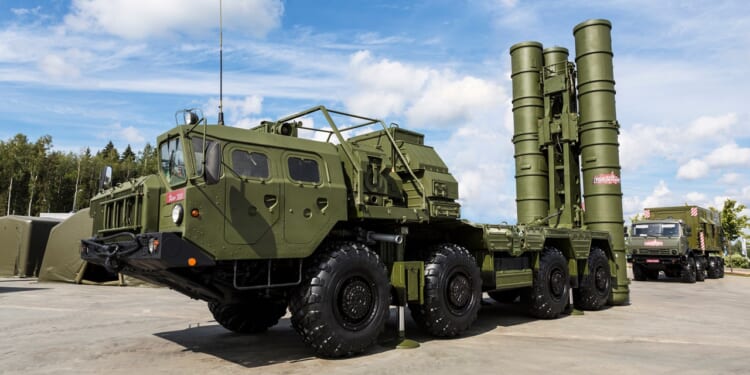India appears intent on buying more Russian-made S-400s after the systems performed well in its recent war with Pakistan.
If there was hope in Washington or among the NATO alliance that India would move away from Russia in any meaningful way, it was dashed this week. India, which has long been the largest purchaser of Russian-made military hardware, appears close to signing a deal for the S-400 Triumf air defense system. Such an acquisition would all but ensure that New Delhi could never acquire the Lockheed Martin F-35 Lightning II fifth-generation fighter, which would firmly integrate the American and Indian militaries for decades to come.
India had previously adopted the S-400, but there had been speculation that it would move away from Russian-made hardware after President Donald Trump floated the idea that the Indian Air Force (IAF) could be offered the F-35 during an Oval Office meeting with Indian Prime Minister Narendra Modi in February.
However, India ultimately rejected the F-35 after Trump announced the United States would impose a 25 percent tariff on Indian goods, which reportedly “shocked and disappointed” Indian officials. Moscow followed up on the rejection by offering a co-production deal that could see India manufacture the Sukhoi Su-57 (NATO reporting name “Felon”) domestically—a priority for New Delhi, which has tried to emphasize indigenous production over foreign purchases.
Stung by Pakistan, India Wants More S-400 Systems
According to a report from the Indian-based ANI News Agency, the IAF was impressed with the performance of the S-400 Triumf, which it claimed shot down five or six Pakistani fighters and an S-130 military transport/spy plane in Operation Sindoor, in which India launched missiles and carried out air strikes at nine sites in Pakistani-administered Azad Kashmir and the Punjab province.
Pakistani officials have disputed the claims, labeling them a “comical narrative.” In past flare-ups, both India and Pakistan have been known to downplay their respective losses while claiming more aerial victories than independently confirmed. Despite the unclear nature of both sides’ losses, though, New Delhi appears to be pleased with the S-400’s performance in the recent conflict.
“The Indian Air Force is looking to buy the missiles in significant numbers to further bolster its air defense capabilities. The discussions with the Russian side are already on in this regard,” an Indian defense official speaking on the condition of anonymity told ANI.
The total value of the contract for a new batch of S-400 air defense systems could be as high as 100 billion rupees ($1.1 billion). The Indian Ministry of Defence is considering the IAF’s proposal.
India and Russia first closed a deal for five squadrons of the S-400 in 2018, valued at $5.43 billion. The first system was delivered in 2021, followed by subsequent deliveries in 2022 and 2023. The first S-400 anti-aircraft missile system was deployed in the Indian state of Punjab.
The final two S-400s are expected to arrive in India by the end of 2026—or potentially 2027, as there have been delays after Russia lost several of the systems in its ongoing war in Ukraine and halted exports to replace those destroyed. Some delays in foreign exports of the S-400 originate from the COVID-19 pandemic, which impacted global supply chains and slowed production.
New Delhi and Moscow have continued to discuss additional purchases of the S-400, as well as the S-500 ‘Prometei’ air defense system. Those acquisitions could be part of the discussions when Russian President Vladimir Putin visits India in December. Talks are expected to include bolstering military hardware cooperation, ANI explained.
About the S-400 Air Defense System
The S-400 Triumf system (NATO reporting name: SA-21 Growler) was developed and produced by Almaz-Antey. It was designed to protect against air strikes, including cruise, tactical, and operational ballistic missiles, as well as intermediate-range missiles, in a radio-jamming environment. It can fire the 40N6 missile, designed to engage targets at a distance of up to 400 kilometers, at speeds up to six times the speed of sound, and at altitudes of up to 30 kilometers, even under intensive enemy fire and jamming. The missile platform has also been used against ground installations in the past, although this is not its primary function.
Since the S-400 first entered service in 2007, many nations have still expressed interest in it, including India and NATO member Turkey. The United States has opposed the sale of the S-400 to its allies, warning that the radars could be used to determine the profiles of American stealth aircraft, helping Russia to shoot them down. Washington has declared that no nation that uses the S-400 can also use the F-35—infamously expelling Turkey from the program after it adopted the Triumf in 2019.
In a sense, the United States has become a victim of its own security procedures—allowing Moscow to use the S-400 as an economic warfare tool, creating rifts with nations such as India, Turkey, and other potential adopters of the air defense platform.
About the Author: Peter Suciu
Peter Suciu has contributed over 3,200 published pieces to more than four dozen magazines and websites over a 30-year career in journalism. He regularly writes about military hardware, firearms history, cybersecurity, politics, and international affairs. Peter is also a contributing writer for Forbes and Clearance Jobs. He is based in Michigan. You can follow him on Twitter: @PeterSuciu. You can email the author: [email protected].
Image: Shutterstock / volkova natalia.
















